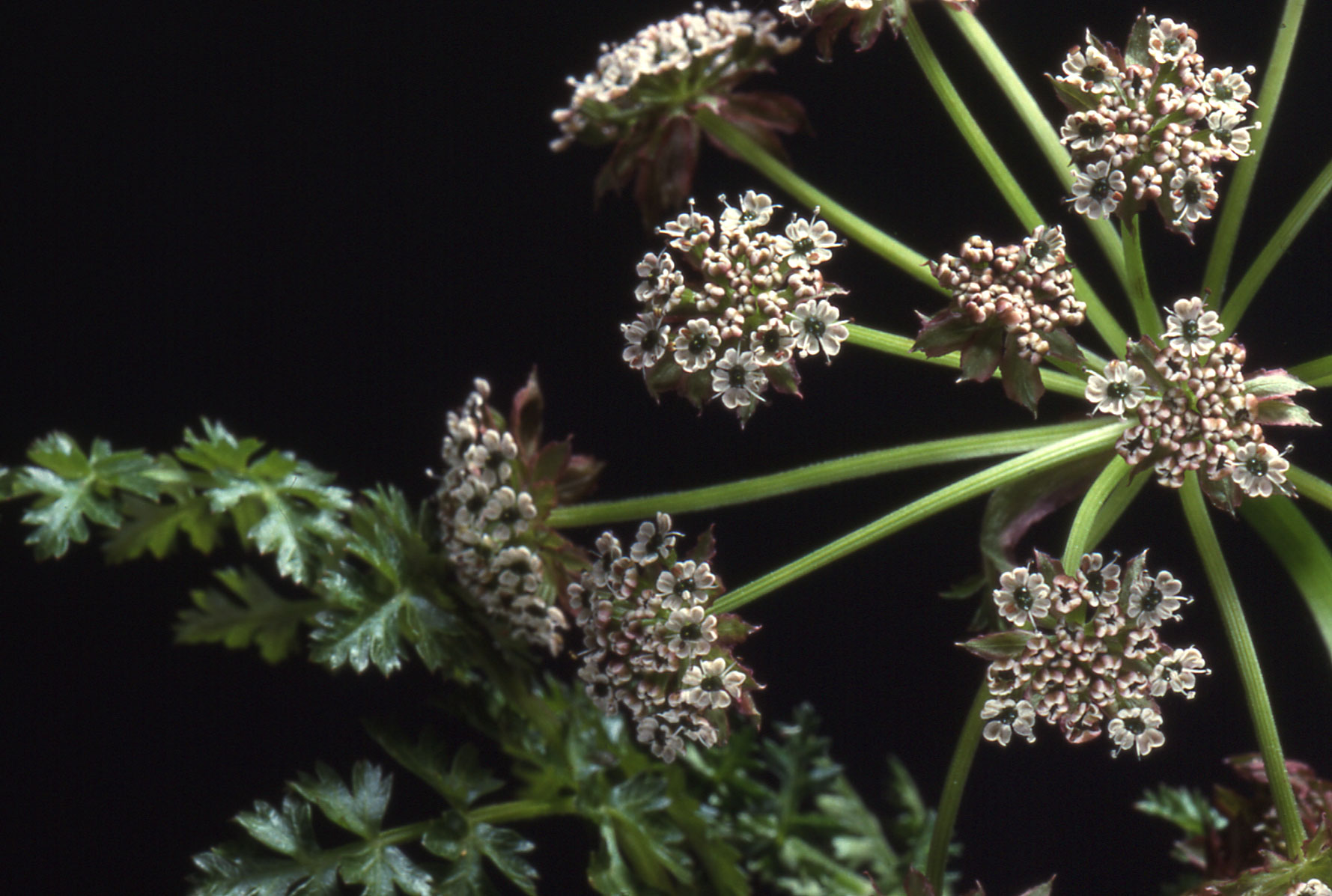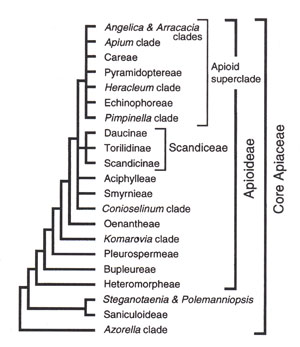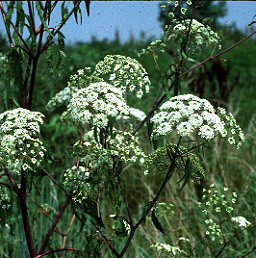| |

The genus Pleurospermum (Apiaceae tribe Pleurospermeae), a widespread and heterogeneous genus of complex and controversial taxonomy |
Systematics of Apiaceae
With their unique "umbrella-like" inflorescences, small white or yellowish flowers, specialized fruits, and often highly-dissected leaves, Apiaceae subfamily Apioideae is easily recognizable, yet these very same features, so similar across many genera, have confounded previous attempts to elucidate its evolutionary history and identify its natural subdivisions. The limits of many genera are also questionable. Without a rigorously constructed estimate of phylogenetic relationships for the subfamily, its classification can never be truly satisfactory, nor can hypotheses in the evolution of its complex chemistry, unique morphology and anatomy, and ecological associates be properly addressed.
|

Summary of relationships among the tribes and major clades of Apiaceae subfamily Apioideae as revealed by phylogenetic analyses of molecular data (Downie et al., 2001). Not all genera included in previous molecular systematic analyses have been assigned to a particular group, although many are placed within the apioid superclade. Angelica & Arracacia clades = tribe Selineae (Spalik et al., 2004). Steganotaenia & Polemanniopsis = tribe Steganotaenieae of subfamily Saniculoideae (Calviño and Downie, 2007) |
Higher Level Relationships in Apioideae
A major goal of my research is to produce a comprehensive estimate of phylogenetic relationships for Apiaceae subfamily Apioideae using primarily molecular data that can be used to revise the classification of the group and better understand evolutionary patterns and processes. Given the large size of the subfamily and its worldwide distribution, this research is highly collaborative. To address issues of phylogeny, high-level analyses of the subfamily are being combined with low-level revisions of particular tribes, subtribes, or genera. Many different kinds of molecular characters are being examined, including chloroplast genes, introns, and intergenic spacers, nuclear ribosomal DNA ITS sequences, and chloroplast DNA restriction sites. These studies were among the first to use chloroplast intron sequences as a source of phylogenetic information. Supplementary data are obtained from variation in size of the chloroplast genome inverted repeat. Based on congruence of relationships among many data sets, eleven tribes have been erected or confirmed as monophyletic in subfamily Apioideae. Additional major clades are also recognized but have yet to be treated formally. Many genera, however, are still of dubious tribe or clade placement. My research is contributing to the ultimate goal of producing a new, phylogenetically-based system of classification for the great family Apiaceae.
|

An umbellifer from Africa showing a very unusual arborescent habit (Steganotaenia araliacea). Photo taken by Mark Watson at the Kirstenbosch National Botanical Garden in Cape Town, South Africa |
Circumscription and Phylogeny of Saniculoideae
In collaboration with Carolina Calviño, phylogenetic relationships within Apiaceae subfamily Saniculoideae are also being elucidated. Included in these studies are the woody African genera Steganotaenia and Polemanniopsis that were classified previously in subfamily Apioideae but show affinity to subfamily Saniculoideae. Results to date confirm the expansion of subfamily Saniculoideae to include Steganotaenia and Polemanniopsis as the new tribe Steganotaenieae. Sister group to Steganotaenieae is tribe Saniculeae, redefined to include the genera Actinolema, Alepidea, Arctopus, Eryngium, Petagnaea, and Sanicula. With the synonymization of Hacquetia into Sanicula, all genera are confirmed as monophyletic. Ongoing research involves a systematic study of New World Eryngium and further elucidation of the relationship between subfamily Saniculoideae and several other anomalous African genera of Apiaceae through international collaborative effort.
|

Photo of Cicuta maculata (tribe Oenantheae), taken by K. R. Robertson along 12 Mile Prairie south of Effingham, Illinois. The genus Cicuta is the most virulently poisonous group of flowering plants native to the north temperate zone
|
Apiaceae Tribe Oenantheae
To fill in the framework phylogeny described above for subfamily Apioideae, detailed studies of particular tribes, subtribes, major clades, and genera have been completed or are currently underway. In collaboration with Krzysztof Spalik (Warsaw University, Poland) and graduate students, a series of papers were published on the systematics and biology of tribe Scandiceae. Now, we are focusing our attention on the systematics of tribe Oenantheae, a group of water-loving umbellifers circumscribed on the basis of previous molecular systematic studies. Generic-level studies of Berula, Sium, Cicuta and Perideridia have been completed, while those of Cryptotaenia, Cynosciadium, Helosciadium, Limnosciadium, Oenanthe and the rachis-leaved umbellifers Lilaeopsis, Oxypolis and Ptilimnium are in progress. In each of these analyses, sampling is comprehensive and all available taxonomic information is being considered, so as to gain deeper insight into the differentiation of these plants. Currently, 17 genera are recognized in tribe Oenantheae with eight of these endemic to North America.
|
|
|
|
|